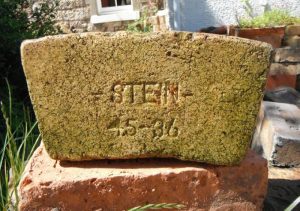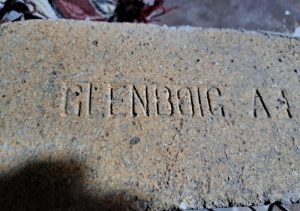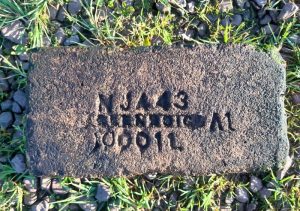A substantial collection of silica fire bricks from steel-making furnaces have now been recovered from a dump site to the rear of the Dalzell Iron and Steelworks, Motherwell, North Lanarkshire. All appear to predate the Ravenscraig Steelworks by around 50 years.
Cartographic evidence shows that spoil from the Dalzell Iron & Steel Works and possibly other nearby works (Ravenscraig Steelworks) were being dumped there between c. 1892 and 1910. Most are Welsh and English but Scottish makers are represented too. Several mystery bricks have been identified but others remain enigmatic.
Below – 1910 – Dalzell Iron and Steelworks.

Below – A photograph showing the banks of debris.

.

Below – The bricks were found by Ian Suddaby and Mark Cranston after a tipoff by David Ivey that groundworks on the site was pulling up thousands of bricks. The vast majority of the bricks were stamped on a stretcher face.
Below – Welsh bricks.
Below – Allen No 1 A – N. B. Allen & Co Ltd, Hirwaun, Aberdare, Wales. Manufacturers of all kinds of silica products. In 1934 the company was taken over by General Refractories.

Below – Allen No 1 – Stamped on a stretcher face. N. B. Allen & Co Ltd, Hirwaun, Aberdare, Wales.

Below – JBJ – J. B. Jenkins & Co, Dinas Fire Brick and Cement Works, Neath, Wales.

Below – Templeton – Templeton Dinas Silica Brick and Cement Company, Templeton, Narberth, Wales.
‘T’ – Potentially stands for Templeton.

Below – Gwersyll – Gwersyll Silica Brick Company Ltd, Wrexham, Wales.

Below – (P)enwyllt – Penwyllt Dinas Silica Brickworks, Penwyllt, Powys, Wales.

Below – A. Y. Dinas – A. Y. Dinas Silica Brick and Lime Company, Graig Works, Mynydd-y-gareg, Wales. (Note – SBH – There is a curiosity here in that this company was registered to an address in Glasgow, Scotland – Does anyone know why?).

Below – R. Dinas – H & H. E. Smart, ‘R’ Dinas Works, Kidwelly, Wales.

Below – Dinica and Dinica No 2 – The exact manufacturer is unknown but it is almost certain of Welsh origins. ‘Dinica’ is thought to be a combination of DINas and silICA. (Note – SBH – Note the reversed ‘N’).

.

.

Below – Wild – William Wild & Sons, Holyhead Silica Works, Anglesey, Wales.

Below – Stephens (It may have been stamped Stephens & Co and just be a damaged example) – Stephens & Co, Dinas Silca Works, Kidwelly, Wales. (Note – SBH – See also S & Co below in the unidentified section).

Below – Stephens & Co – Stephens & Co, Dinas Silca Works, Kidwelly, Wales.

.

Below – English bricks.
Below – Gregory – (Note – SBH – The ‘E’ is reversed). John Gregory & Co, Fire Brick Works and Clough Collieries, Deepcar, Sheffield. Specialist silica brick manufacturers.

Below – Reddish (broken) – (Note – SBH – Gregory and Reddish later combined talents to become Gregory, Reddish & Co Ltd, Deepcar, nr Sheffield).

Below – G (Broken) – Gregory

Below – 15/09/1933 – Sheffield Independent – An article entitled Gregory Reddish and Co Ltd. It states that bricks stamped ‘G’ were Gregory silica bricks.

Below – PH – Pickford Holland & Co, Attercliffe Road, Sheffield, England. It is not clear but the stamp is ‘PH’ as per the stylised example on the advert below.

Below – 1912 – Advert for Pickford Holland.

Below – Lowood – J. Grayson Lowood & Co Ltd, Deepcar, Sheffield. Silica brick manufacturers.

Below – 30/07/1938 – Grayson Lowood were taken over by General Refractories but the brand name was continued.

Or possibly more likely given the assumed date of this Lowood brick, c.1892 – c.1910 – The Lowood Wharncliffe Gannister Brick Works (See next entry).
10/03/1888 – Sheffield Daily Telegraph – It is satisfactory to note that in some quarters there is a great improvement in trade. One local firm, Messrs. J. Grayson, Lowood, and Co., of Attercliffe and Deepcar, have so large a demand for their silica bricks, that they are making a considerable increase in their plant at their Deepcar Works, and have also purchased A large brick works and plant at Middlesborough-on-Tees. This latter establishment, which has been worked by the Scotch Fire Brick Company (Limited), will be known as “The Lowood Wharncliffe Gannister Brick Works,” and will be carried on as a branch establishment to the Sheffield and Deepcar Works. The raw material used in the manufacture of the silica bricks and other goods will be obtained from the firm’s Wharncliffe Quarries at Deepcar, and manufactured by workmen from their regular staff. By these means, Messrs. Lowood and Co. will be enabled not only to execute orders with promptitude, but also to make the quality of the goods supplied from Middlcsborough equal to those manufactured in Sheffield. This speciality so closely associated with the iron and steel trades has made a very rapid advance of late years.
Below – Silica – Examples are stamped on the bed and on the stretcher.
Oughtbridge Silica Fire Brick Company, Yorkshire Silica Fire Brick Works, Oughtbridge, Sheffield. The ‘Special reports on the mineral resources of Great Britain” – Geological Survey 1920 states Oughtbridge Silica Fire Brick Company …”Products: various kinds of refractory goods are manufactured of which ‘best silica brick’ and retort brick are chief. Silica cement and ground ganister are produced. Trade mark – ‘silica’. (Note SBH – They certainly had the trademark silica in 1920 but it is not known for certain if they also had the ‘silica’ trademark during the time frame we believe these bricks were manufactured.

.

.

Below – Hunnex (Obscured) – West Hunwick Silica and Firebrick Co. Ltd, Hunwick, Durham.

Below – Pease – Pease & Partners Ltd, Bankfoot Brickworks, Crook. Manufacturers of silica bricks.

Below – Girling – W. H. Girling & Co Ltd, Crook, Durham. Silica brick manufacturers.
(Note – SBH – There was a GR-Stein or Glenboig connection with a Mr Girling but this was well after the date we believe these bricks were used and dumped – 25/07/1939 – Sheffield Daily Telegraph – Mr. W. G. Girling has been appointed a director of General Refractories, Ltd., and of Glenboig Union Fire Clay Company. He is vice-chairman and managing director of Henry Foster and Company).

Below – GRs B – General Refractories. The ‘B’ may refer to the Bawtry Fire Brick Works, Doncaster which manufactured silica bricks.

Below – Diazite – This is a heavy brick weighing 6.3kg. Diazite was a trademark of General Refractories.

Below – Scottish bricks.
Below – Eglinton – The Eglinton Silica Brick Company Limited, Dundyvan, Coatbridge, Scotland.

.

Below – Bluebell – Examples stamped on the bed and on the stretcher.
- Stein, Castlecary Fireclay Works, Castlecary, Stirlingshire.
- Stein, Manuel Firebrick and Refractory Works, Whitecross, Stirlingshire.
- Stein & Co, Anchor Brickworks, Denny, Stirlingshire.
- Milnquarter Fireclay & Gannister Works, Bonnybridge, Stirlingshire.

.

Below – Myrtle 11 –
- Stein, Castlecary Fireclay Works, Castlecary, Stirlingshire.
- Stein, Manuel Firebrick and Refractory Works, Whitecross, Stirlingshire.
- Stein & Co, Anchor Brickworks, Denny, Stirlingshire.
- Milnquarter Fireclay & Gannister Works, Bonnybridge, Stirlingshire.

Below – MSB Co – Meltham Silica Brick Company, Meltham, nr Huddersfield.

Below – Bramall – Possibly Charles and Mary Bramall, Larkhall Silica Brick & Coal Company Ltd, Caledonia Brickworks, Larkhall, South Lanarkshire.

Below – SSBCo – This could relate to the Scottish Silicate Brick Company Limited, Coatbridge, North Lanarkshire. (Note – SBH – However, many silica bricks found on the same site were manufactured in Wales so the stamp could also represent the Swansea Siemens Brick Co, Landore, which produced silica bricks and just to confuse further, Stephens Silica Brick Company Ltd, Kidwell, Wales (‘Stephens’ stamped bricks were also found on the same site).

Below – WCW – Possibly made by or for William C. Wood & Sons, fireclay manufacturers and Plumbago Crucible makers, Lambhill Street, Paisley Road, Glasgow.

Below – WW – Possibly made by or for William C. Wood & Sons, Fireclay Manufacturers and Plumbago Crucible Makers, Lambhill Street, Paisley Road, Glasgow.

.

Below – Unidentified brickmarks.
Below – Cheker – Unidentified manufacturer.

Below – S & Co – Quite possibly Stephens and Company, Dinas Silica Works, Kidwelly, Wales. (Note – SBH – There are two .. above the ‘o’ of Co).

Below – Dialite (Unclear but it looks like Dialite) – Photographed on-site by David Ivey. This was left at the locus. From the photograph, it is uncertain if this is a fire brick or a silica brick. This is the only reference we can come up with so far. 1941 advert for Harbison-Walker, USA – Dialte – fire brick.

.

Below – Chears or Clears (The exact stamp is uncertain) –

Below – Cleve 2 – (Note – SBH – The ‘2’ is upside down and appears to have been stamped separately from the main stamp). Unidentified manufacturer. Some additional information here.

Below – Cleve

Below – Mx – Unidentified manufacturer. This appears to be a side-stamped silica brick Possibly a Meltham Silica Fire Brick Company product but there is no evidence to support this.

Below – W or WD perhaps?

Below – A mystery stamp which looks similar to ” – / >”.

.

A mass of Scottish fire bricks were also found on-site including:-
Morningside Altos
Douglas
Douglas 39
Castlecary
Thistle
Bonnybridge
Bonnybridge Brand
Glenboig
Thistle
Dated Heathfield 1903 and 1904.
Heathfield 3
Heathfield 4
Garnkirk Warranted
Gannister Dougal
Lindsay
Boghead Glasgow and Glasgow Boghead
Bea – a broken brick which may have been stamped Beaver (Roughcaste Firebrick Works)
and
Dewar engineering bricks
Below – This fire brick was also found on-site and it is believed to depict the British Steel symbol. It is unknown what the letter ‘N’ below the ‘S’ represents. The manufacturer is unknown. Were they made by British Steel at an unknown brickworks or made by a brick manufacturer for British Steel and stamped with their logo. (If indeed it is the British Steel logo!).

Below – British Steel logo.




































































